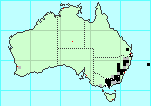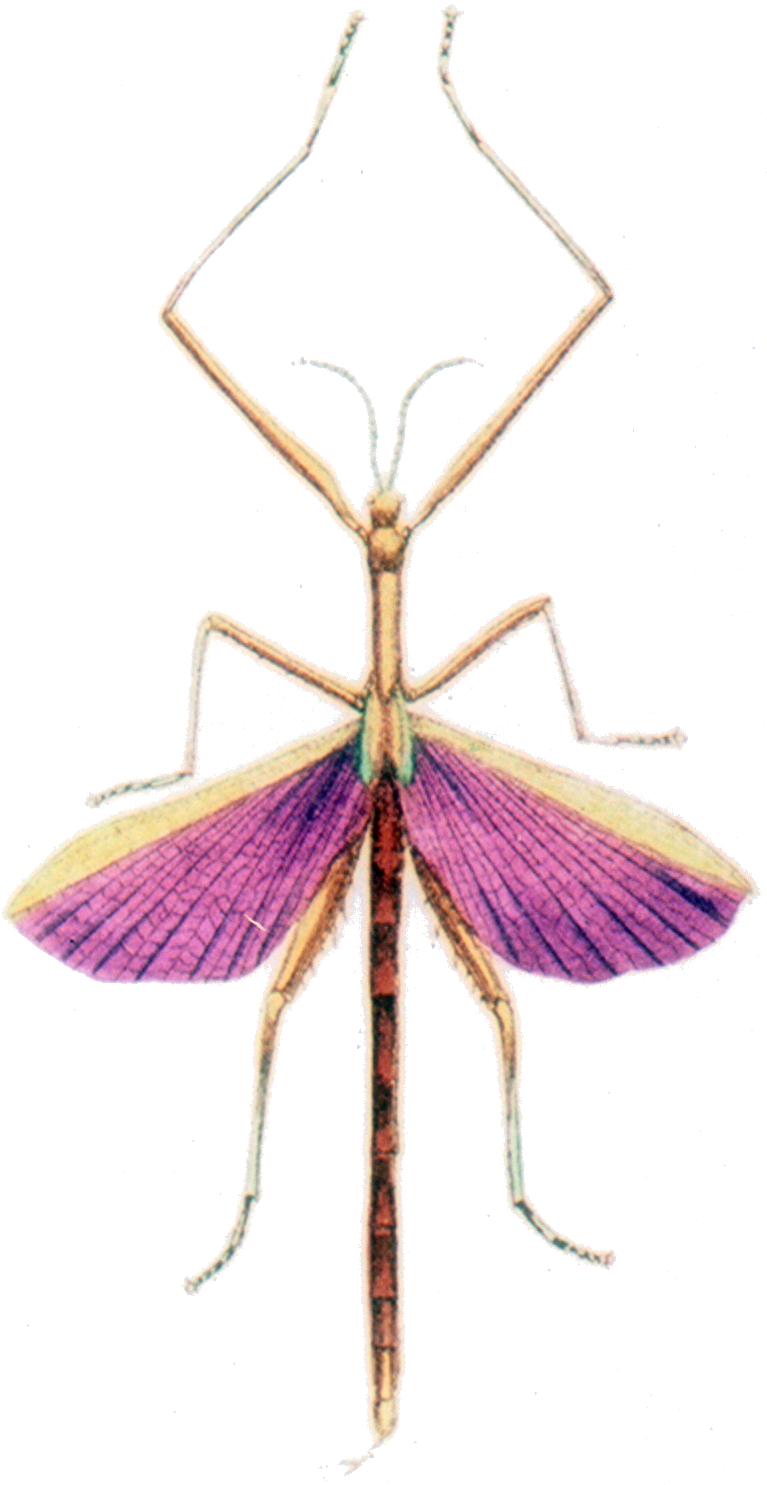Common Name:
Violet-winged stick insect
Spur-legged stick insect
Identification:
Green, with the external edge of the elytra yellowish; the wings, with
the exception of the coriaceous margin, purplish; the four hinder thighs
spiny beneath. May be readily distinguished by the colour of the wings,
and by the long tooth under the middle part of the hinder thighs.
(Leach,
1814)
Male:
The male is fully winged, has inflated hind femora bearing two or three
large black spines ventrally
(from Key, 1991)
Female:
The female is shorter-winged and flightless, with the hind femora
unspecialised.
(from Key, 1991)
The costal area is yellowish green tinged with brown; the anterior margin
bright yellow, with the outer ridge white; the tegmina are similar to
the latter in colour and markings: but the most remarkable character
which this insect possesses, is the immense strength and thickness of the
hind thighs, though of a moderate length in comparison with the size of
the insect; they are also armed with three strong, long, black spines,
situated beneath, the one near the base is smaller than the other two;
they are also strongly dentated, with elevated longitudinal lines on the
upper surface, and are of a reddish yellow; the head is small without any
stemmata; the mesothorax is rather long, narrow, but wider at the base,
and is brownish yellow, covered with minute tubercles; the abdomen is
reddish violet, with the tip green, but the leaflets are reddish violet;
the four fore-legs are green, with the thighs of the intermediate pair
dentated.
(from Gray, 1833)
Lifesspan: nymphs take 4 months to mature,
the adult stage a further 2 months.
The mature female oviposits during late summer and autumn.
The eggs hatch when the average temperature rises,
which is usually from November to December.
Nymphal development is usually complete
by the end of March, five (male) or six (female) nymphal instars.
Eggs from unmated females yielded female individuals only, and thus the
parthenogenesis appears to be thelytokous (however it is rare, 0.6%).
(from Campbell & Hadlington, 1967)
Habitat:
Arborial, top of host splants (not necessarily top of canopy).
Most of the Eucalyptus species are acceptable as food, though
there are preferences within the genus. While no quantitative tests
have been done on food preferences it has been noted in nature that
the narrow-leaved “peppermints” E. radiata Sieb. and
E. robersoni Blakely, the broad-leaved “peppermint”
E. dives Schauer and the “gums” E. viminalis
Labill., E. huberiana Naud., E. dairympleana Maiden,
E. mannifera (A. Cunn. Herb.) Mudie, E. stellulata
Sieb., E. pauciflora Sieb., and E. bicostata Maiden,
Blakely and Simmonds appear to be favoured species, and are the first
to be defoliated. Other species which are known to have
been severely defoliated are E. laevopinea R. T. Baker,
E. obliqua L'Hérit., E. delegatensis, R. T. Baker,
and E. fastigata Deane and Maiden, though these appear to be
less favoured than the former groups. E. andreana Naud. is an
acceptable species and has been used for most laboratory rearings.
Some Eucalyptus species are avoided and these will only be eaten
when there is no choice of food.
(from Campbell & Hadlington, 1967)
Similar Species:
Rearing Notes:
Forrestry Commision of N.S.W reared this specied for many years
while studying it.
Parthenogenic eggs give rise to male stick-insects in
the next generation, thus increasing the chance that the females
of that generation will be mated normally. (Hughes,
1975)
For a stick insect with body length 62mm, to keep 2 adult females,
you need a cage at least 300mm high, 140mm deep and 140mm wide.
 Range:
Range:
Dense populations of both these species of phasmatids have been recorded
only from highland (above 2,000 ft) forest areas of southeastern
Australia, though occasional insects are found at low altitudes and
near the coast.
(from Campbell & Hadlington, 1967)
This insect has a widespread distribution throughout the forested areas
of southeastern Australia, mainly in the highland region and occasionally
in the coastal region.
NE coastal, SE coastal, Murray-Darling basin, Gulfs, QLD,
NSW, VIC, TAS, SA, Lord Howe Is.
Status:
Not endangered. Know to occur in plague proportions from time to time.
References
-
Bay Books (1981).
Australian Insects 1.
Bay Books, Rushcutters Bay, ISBN 0 85835 452 7, pp. 34-36
-
Balderson, J., Rentz,
D.C.F. and Roach, A.M.E. (1998).
in
Houston, W.K.K. & Wells, A. (1998) (eds)
Zoological Catalogue of Australia.
Vol. 23.
Archaeognatha, Zygentoma, Blattodea, Isoptera, Mantodea, Dermaptera,
Phasmatodea, Embioptera, Zoraptera.
Melbourne: CSIRO Publishing, Australia (ISBN 0643 06035 9).
pp. 347 - 376.
-
Bedford, G.O. (1968).
Notes on the biology of some Australian stick insects (Phasmatodea),
Journal of the Australian Entomological Society,
7: 81-82
-
Bedford, G. O. (1970).
The development of the egg of Didymuria violescens
- embryology and determination of the stage at which first
diapause occurs.
Australian Journal of Zoology 18: 155-169
-
Bedford, G. O. (1976).
Description and development of the eggs of two stick insects
from New Britain.
Journal of the Australian Entomological Society 15: 389-393
-
Bedford, G.O. (1978).
Biology and ecology of the Phasmatodea.
Ann. Rev. Entomol. 23: 125-149
-
Campbell, K.G., 1961.
The effects of forest fires on three species of Stick Insects
(Phasmatidae Phasmatodea) occurring in plagues in forest areas of
south-eastern Australia.
Proceedings of the Linnaean Society of New South Wales,
86(1): 112-121
-
Campbell, K.G., 1966.
A review of research on disease and insects affecting forest trees in
Australia, New Zealand, and Oceania"
“Breeding pest-resistant trees”
Proceedings of a N.A.T.O. and N.S.F. Symposium
held at The Pennsylvania State University,
August 30 to September 11, 1964.
pp. 43-44.
Pergamon Press, 1966.
-
Campbell, K. G., Hadlington, P., 1967.
The biology of the three species of phasmatids which occur in
plague numbers in forests of south eastern Australia.
Forestry Commission NSW Res. Note No. 20, 38 pp.
-
Clark, J.T. (1976).
The eggs of stick insects (Phasmida): a review with
descriptions of the eggs of eleven species.
Syst. Ent. 1: 95-105.
-
Froggatt, W.W. (1905).
Notes on stick or leaf insects, with an account of Podacanthus
wilkinsoni as a forest pest, and the spiny leaf insect Extatosoma
tiaratum, in the orchard.
Agricultural Gazette of New South Wales 16: 515-520
-
Goode, J. (1980).
Insects of Australia.
Angus & Robertson, Sydney.
ISBN 0 207 13427 8.
pp. 39-42
-
Gray, G.R. (1833).
The Entomology of Australia in a Series of Monographs. Part 1.
The monograph of the genus Phasma.
London: Longman & Co. 28 pp. 8 pls
-
Gray, G.R. (1835).
‘Synopsis of the Species of Insects Belonging to
the Family of Phasmidae.’ 48pp.
(Longman, Rees, Orme, Brown, Green and Longman: London.)
-
Hadlington, P.W., and Hoschke, F. (1959).
Observations on the ecology of the
phasmatid Ctenomorphodes tessulata (Gray).
Proceedings of the Linnaean Society of New South Wales.
84(2): 152-158
[I already have this one, except for plates 5 and 6, and possibly
page 159 (references). He also refers to figure 3 in the text, but none
appears in my copy; it may be on page 159.]
-
Hadlington, P.W. (1965)
Variations in diapause and parthenogenesis associated with
geographic populations of Podacanthus wilkinsoni Macl.
Journal of the Entomological Society of Australia, 2: 1-5
-
Hadlington, P.W., and Johnston, J.A. (1982).
An Introduction to Australian Insects.
University of New South Wales Press,
ISBN 0 86840 465 9,
pp. 28-29
-
Heather, N.W. (1965).
Studies on female genitalia of Queensland Phasmida,
Journal of the Entomological Society of Queensland,
4: 33-38.
-
Hughes, R.D. (1975).
Living Insects,
William CollinsSydney,
ISBN 0 00 211437 2
-
Hughes, L., 1996.
When an Insect is more like a Plant.
Nature Australia, 25(4): 30-38
-
Key, K.H.L. (1957).
Kentromorphic phases in three species of Phasmatodea.
Australian Journal of Zoology 5: 247-284
-
Key, K.H.L. (1970).
Phasmatodea (Stick-insects). pp. 394-404 in CSIRO (ed.) The
Insects of Australia. A textbook for students and research workers.
Melbourne: Melbourne University Press, Vol. 1, 1st Edn.
-
Korboot, K. (1961)
Observations on life histories of
Acrophylla tessellata Gray and
Extatosoma tiaratum Macleay (Phasmida).
University of Queensland Papers Department of Entomology,
1(2): 161-69,
The University of Queeensland Pres, St. Lucia, 24th August.
-
John, B., Rentz, D.C.F. & Contreras, N. (1987).
Extensive chromosome variation in the stick insect genus Sipyloidea
Brunner von Wattenwyl (Phylliidae: Necrosciinae) within Australia, and
descriptions of three new species.
Invertebrate Taxonomy, 1: 603-630
-
Leach, W.E. (1814).
Phasma violescens
In
The Zoological Miscellany: being Descriptions of
New or interesting Animals. Vol. 1. (London),
pp. 25-26.
-
Rainbow, W.J. (1897).
Catalogue of the described Phasmidae of Australia.
Records of the Australian Museum, 3(2), 37-44.
[Note that he made a mistake re Extatosoma popa and E. tiaratum
according to
Gurney, A.B. (1947).
Notes on some remarkable Australasian walkingsticks, including a
synopsis of the Genus Extatosoma (Orthoptera: Phasmatidae).
Annals of the Entomological Society of America. 40(3): 373-396.
.]
-
Readshaw, J. L. (1965).
A theory of Phasmatid outbreak release.
Australian Journal of Zoology, 13: 475-90
-
Readshaw, J. L., Bedford, G. O. (1971)
Development of the egg of the stick insect Didymuria violescens
with particular reference to diapause.
Australian Journal of Zoology, 19: 141-158
-
Rentz, D.C.F (1996).
Grasshopper Country,
Chapter 16,
Phasmatodea: Leaf and Stick Insects,
pp. 244-257
- Shipp, E. (1963).
Rates of development in eggs from three populations
of Didymuria violescens (Leach) (Phasmatodea).
Proceedings of the Linnean Society of New South Wales,
86:3, pp. 287-294.
-
Tepper, J.G.O. (1902).
List of the Described Genera and Species of the Australian and Polynesian
Phasmidæ (Spectre-Insects).
Transactions of the Royal Society of South Australia, 26: 278-287.
-
Vickery, V.R. (1983).
Catalogue of Australian stick insects (Phasmida,
Phasmatodea, Phasmatoptera, or Cheleutoptera). CSIRO
Australian Division of Entomology Technical Paper, No. 20, 15 pp.
- Search Google for
Didymuria violescens,
or search Google Scholar for
Didymuria violescens.
Synonyms:
-
Acrophylla roseipennis Gray, 1835
-
Acrophylla violascens Gray, 1835
-
Acrophylla virginea Stål, 1875
-
Cyphocrania violascens Burmeister, 1838
-
Cyphocrania violescens
Clark, 1976
-
Didymuria discolor Stål, 1875c
-
Diura discolor Stål, 1875c
-
Diura roseipenne Gray, 1833
-
Diura roseipennis Gray, 1833
-
Diura violascens Gray, 1833
-
Diura virginea Stål, 1875c
-
Phasma violescens Leach, 1814
Copyright © 2000-2003
Peter Miller
This page was last changed 20-Sep-2006.
|

|

|






 Range:
Range: 
